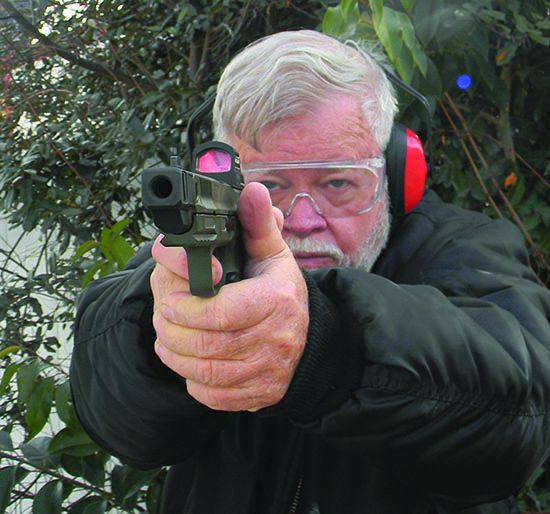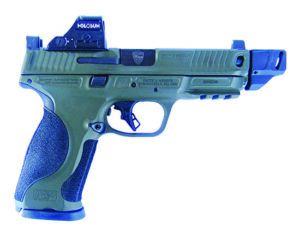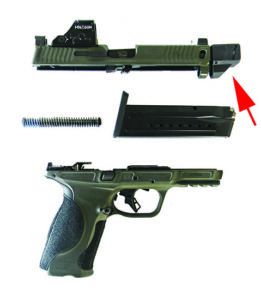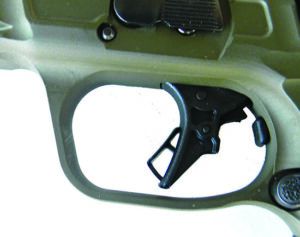
We recently had a chance to shoot two metal-frame striker-fired compensated 9mm Luger pistols from SIG Sauer and Smith & Wesson to assess how we liked their aluminum receivers, extended magazines, night sights, and other features. In the end we think one pistol is better for competition and the other better for personal defense, but either would cross over to the other’s territory with nothing to be ashamed of.
The first handgun was SIG Sauer’s P320 AXG Legion, $1400. The AXG version is SIG’s answer to the popular trend of offering a metal-frame version of a polymer-frame striker-fired handgun. The P320 AXG Legion is similar in outline to the P320 and the U.S. military-issue M17 — but differs in important details. The trigger action and sights are the same as most P320 models, while the Legion features a flat trigger, compensator, and aluminum frame.
The Smith & Wesson 2023 SPEC Series M&P9 Metal M2.0 13974, $949, is finished in a tactical OD green that is attractive over the stainless slide and aluminum frame. The slide features both forward and rear cocking serrations. The front serrations are dished in more than it appears in images. This makes for good leverage, although neither pistol was difficult to rack.
We used two types of ammunition during the combat-firing evaluation at the usual 7, 10, and 15 yards, and we also combat fired at 25 yards, which is a typical competition range. The first fodder was Federal American Eagle 147-grain Syntech Training Match. Heavier bullets often provide better accuracy in the 9mm, we’ve found. The second round was a test of accuracy and feed reliability as we fired Federal Train & Protect 115-grain JHPs. During combat firing, we drew the big SIG and Smith pistols from a Galco belt slide or a Galco Yaqui slide, large size. In benchrest firing, we added Black Hills 124-grain JHPs. Here’s what we thought of the pistols individually:
Smith & Wesson 2023 SPEC Series M&P9 Metal M2.0 13974 9mm Luger
$949
Gun Tests grade: A [BEST BUY]
The Smith & Wesson offers a lot of value with grip inserts, a knife, and four magazines in a large lockable case. You may even remove the compensator if you desire. This is a great-shooting pistol, simply an ace overall for personal and home defense.

| Action Type | Double-action semi auto |
| Overall Length | 8.5 in. |
| Overall Height | 5.5 in. |
| Maximum Width | 1.3 in. |
| Weight Unloaded | 30.0 oz. |
| Weight Loaded | 36.1 oz. |
| Barrel Length | 4.8 in. |
| Slide | Olive Drab Cerakote-finished stainless steel |
| Slide Retraction Effort | 18.6 lbs. |
| Receiver | Aluminum |
| Front Strap Height | 2.5 in. |
| Rear Strap Height | 3.75 in. |
| Grip Thickness | 1.2 in. |
| Grip Circumference | 5.75 in. |
| Magazines | (2) 17 round, (2) 23 round |
| Rear Sight | Suppressor-height 2 dot night sight |
| Front Sight | Fixed Suppressor-height single dot night sight |
| Trigger Pull Weight | 5.4 lbs. |
| Trigger Span | 2.65 in. |
| Sight Radius | 6.25 in. |
| Safety | No manual safety |
| Warranty | 1 year |
| Telephone | (800) 331-0852 |
| Website | Smith-Wesson.com |
| Made In | U.S. |
To start, let’s look at the Spec package supplied in a briefcase-sized hard case. The pistol is supplied with four magazines. Two are 17-round magazines and two are 23-round capacity. The 17-round magazines allow easier concealed carry. The magazines are not difficult to load to full capacity. These are the same magazines supplied with the Smith & Wesson FPC 9mm carbine. The SIG magazines are equally top quality and also easily loaded to full capacity, but Smith & Wesson’s offering with four magazines is more versatile. The box also contains three grip inserts. The SIG doesn’t have grip inserts at all. To change the grip profiles of the SIG P320 AXG Legion would require another grip module. SIG-supplied modules are several hundred dollars ($400 from SIG, as little as $299 online). The S&W pistol was fitted with the small insert to accommodate our most slightly built rater. The system installation is simple: Twist a rod buried in the grip and remove it from the bottom of the grip frame. The grip simply slips off. The case also contains an Allen wrench for removal of the compensator. There is also Loc-tite included for re-fitting the Faxon compensator. The compensator would require heating for removal, something we did not attempt. A thread cover for the barrel is included. A challenge coin similar to the Legion coin is included. A gun lock and owner’s manual, standard fare, is included with both the SIG and the S&W. The Smith & Wesson M&P SPEC is also supplied with a neat little hooked-blade knife and sheath. While minimal, it is useful. The Spec pistol is lighter than the SIG and a bit thinner.

Next, let’s look at M2.0 improvements over older M&P pistols. The current grip is more aggressive, with the balance of adhesion and abrasion more towards abrasion. The Spec is downright raspy but never drew blood. It isn’t as uncomfortable as firing an M&P 10mm. The M2.0 dimensions seem the same, but the M2.0 offers four backstraps versus the first-generation guns with three. Magazines interchange. The beavertail actually measures a bit shorter on the M2.0, but remains comfortable. The stainless internal chassis has been strengthened. The trigger action has been redesigned and should not only offer a better let off but should be more reliable. We experienced trigger problems in Shield-size guns. The new design eliminates the previous problems, according to our gunsmith. The M2.0 guns are definitely improved over previous M&P guns.
There are three lightening cuts in the barrel, one on each side and one over the barrel. The top cut is much longer than the side cuts. Be careful when using the forward cocking serrations! It is easy to get a finger pinched between the slide and compensator. Or a shirt sleeve. Just something to be aware of. The 4.8-inch barrel features a Faxon compensator. The threaded-on unit has enough free space between slide and compensator that the slide doesn’t slam the compensator during cycling. The Smith & Wesson handgun features suppressor-height sights with three-dot night-sight inserts. We rated these superior to the SIG P320 AXG Legion sights, not necessarily in sight picture but because they allowed co-witnessing with a red dot that the SIG did not. Yet, the Spec’s sight were properly sighted for 124-grain 9mm loads at combat distance.
Moving to the receiver, the pistol features an ambidextrous slide lock. The reversible magazine catch is now metal compared to the original M&P plastic latch. The grip fits most hands better than the larger SIG. The S&W grip flares but slightly at the base, and the magazine well is beveled. During speed loads, the SIG P320 AXG Legion wins hands down on this. There is a real possibility of shaving seconds off a speed load with the SIG.
The S&W features finger-relief grooves to shorten trigger reach. The Smith’s aluminum frame, unlike the SIG, maintains the ability to change out the grip strap. The supplied grip strap is almost sand paper abrasive. (Talon grip tape in a milder grit will alleviate this concern.) The grip did not bring blood or abrade the palm, but it is noticeable. The front strap doesn’t appear changeable. There was a slight, almost imperceptible, motion in the front insert. It did not move when held during firing.

A big difference between the two test guns is the trigger action. The Smith & Wesson flat trigger features a trigger-lever safety that prevents lateral discharge. The trigger breaks cleanly at 5.2 pounds with a sharp reset. The trigger is controllable in rapid fire and offers excellent accuracy potential. We prefer this trigger as a carry-gun trigger versus a competition-gun trigger. There is a trigger stop built into the frame that prevents overtravel. The trigger is superior to Glock triggers and most every other factory double-action-type striker-fired trigger.
Firing the pistol over the combat course, we had good to excellent results. Firing over the 7- to 25-yard test course, we were impressed with the Spec’s performance. It is easily among the best-shooting striker-fired pistols we have fired, although striker-fired metal-frame 9mm pistols is a thin file at present. The pistol raters were impressed by how quickly double taps, hammers, and controlled pairs were carried out.
Our Team Said: The Spec pistol handles well and delivers the goods in rapid-fire combat shooting. Compared to the SIG P320 AXG Legion, results were similar. A few fired the S&W Spec better, but for most shooters, the groups were tighter and splits slightly faster between shots with the SIG. Addressing multiple targets, most felt the slimmer, more abrasive grip of the S&W Spec afforded better control.
The final verdict was that while the SIG was a better shooter, the contest was very close. In bench accuracy, the contest was not so close. The Smith & Wesson is very accurate, with five-shot groups as small as 1.5 inches, but most closer to 2.0 inches. The SIG simply was more accurate by a noticeable margin. By any standard, the Smith & Wesson Spec is well suited to personal-defense use and some forms of competition. We had to give the Smith & Wesson a solid A rating. Its total package presentation — lockable case, grips, detachable compensator — make the Spec a better value, in our opinion.
| 9MM LUGER RANGE DATA | |||
| Federal Train & Protect 115-grain VHP TP9VHP1 | SIG Sauer P320 AXG Legion | S&W Spec M&P9 Metal M2.0 | |
| Average Velocity | 1102 fps | 1156 fps | |
| Muzzle Energy | 310 ft.-lbs. | 341 ft.-lbs. | |
| Smallest Group | 1.25 in. | 1.9 in. | |
| Average Group | 1.8 in. | 2.5 in. | |
| Federal American Eagle 147-grain FMJ AE9SJ3 | SIG Sauer P320 AXG Legion | S&W Spec M&P9 Metal M2.0 | |
| Average Velocity | 899 fps | 940 fps | |
| Muzzle Energy | 264 ft.-lbs. | 288 ft.-lbs. | |
| Smallest Group | 1.25 in. | 1.8 in. | |
| Average Group | 1.7 in. | 2.5 in. | |
| Black Hills Ammunition 124-grain JHP | SIG Sauer P320 AXG Legion | S&W Spec M&P9 Metal M2.0 | |
| Average Velocity | 1108 fps | 1150 fps | |
| Muzzle Energy | 338 ft.-lbs. | 364 ft.-lbs. | |
| Smallest Group | 1.0 in. | 1.9 in. | |
| Average Group | 1.7 in. | 2.6 in. |
We fired groups at 25 yards from a benchrest position using an MTM Case-Gard K-Zone Shooting Rest. We used a Competition Electronics Pro Chrony to measure muzzle velocities.
Written and photographed by Gun Tests Staff. GT
























